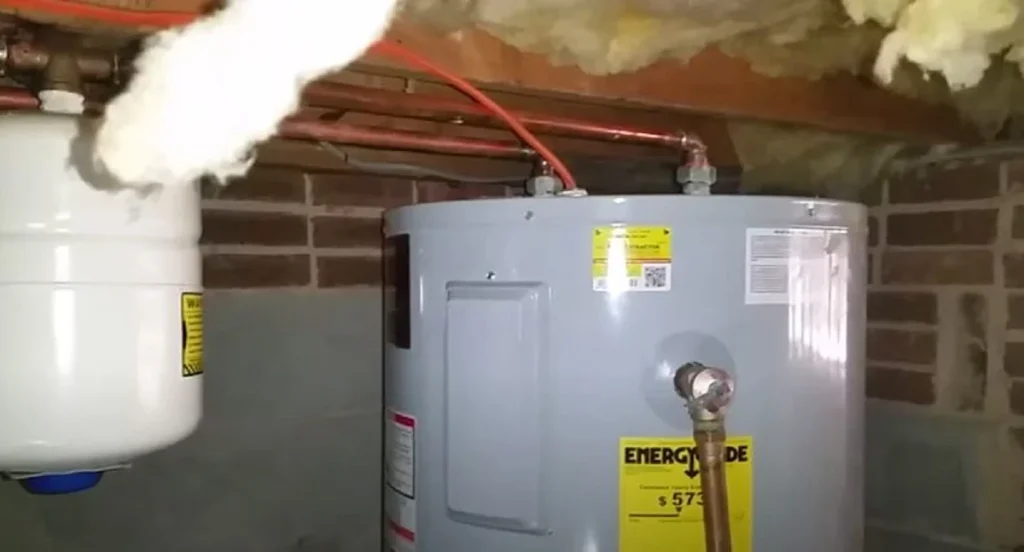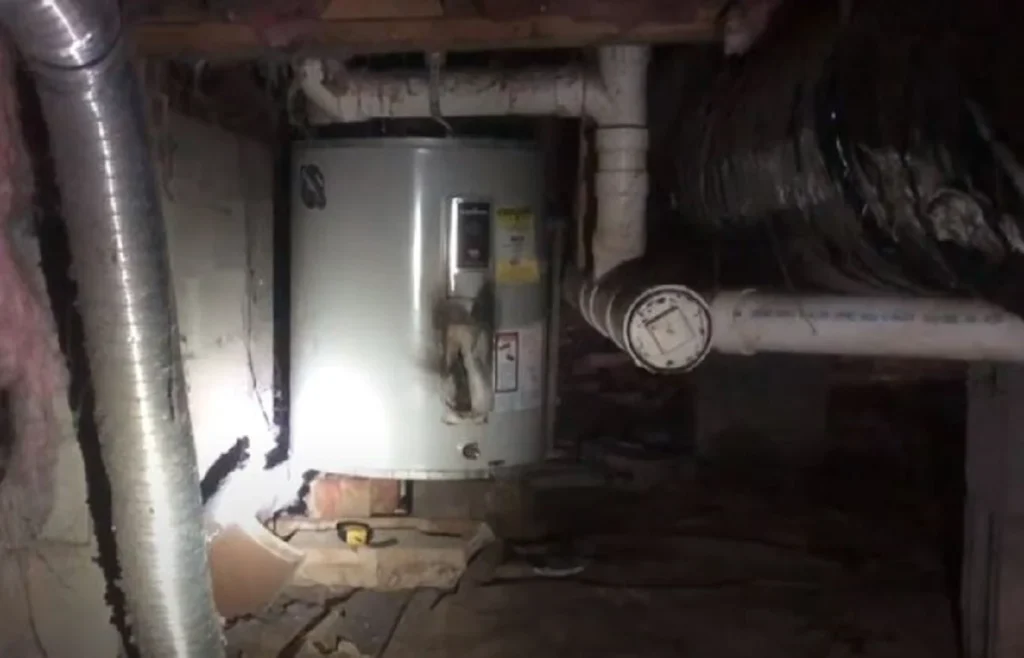| Note: This article may contain affiliate links, which means if you make a purchase following our links won’t cost you extra, but we may earn a commission. Learn more |
Placing a water heater in a crawl space is a topic often discussed by homeowners and professionals. The feasibility of this depends on various factors, including the type of water heater, the crawl space’s conditions, and adherence to building codes.
When considering a water heater for a crawl space, it’s essential to ensure that the area is temperate enough to house the heater. This is particularly relevant as it’s common to move these units to non-living spaces.
One critical aspect is the manufacturer’s approval for crawl space installation. Each water heater type, be it tankless, gas, or electric, comes with specific requirements and limitations.
For instance, gas water heaters are generally not recommended to be installed below grade, such as in a dug-out pit in a crawl space. On the other hand, electric heaters, including tankless models, can be installed provided they are on a suitable circuit with adequate amperage. The use of extension cords, if necessary, should also meet the power requirements.
Water heater leaks in crawl spaces present less risk compared to living areas, but it’s vital to monitor and maintain these systems regularly. An improperly maintained water heater in a damp crawl space can lead to issues like rust and water damage.
Crawl space heaters can affect humidity levels, potentially leading to moisture-related problems.
In terms of preventing freezing, there are practical solutions. Insulating the crawl space and using a small, low-profile space heater or radiant floor heating helps maintain temperature.
Another method involves placing a low-watt lightbulb near vulnerable pipes. Proper ventilation and air for combustion are also crucial for gas water heaters to ensure safety and efficiency.
Can You Put a Heater in a Crawl Space?
Installing a heater in a crawl space might seem like an unconventional choice, but it can be a practical solution for many homeowners. This approach is particularly useful in regions with colder climates where preventing pipe freeze is a priority. A heater in the crawl space helps maintain a stable temperature, reducing the risk of pipes bursting due to freezing.
However, the decision to install a heater in this space should not be taken lightly. It requires careful consideration of the crawl space’s size, ventilation, and accessibility. Adequate ventilation is crucial to prevent moisture buildup, which can lead to mold and mildew.
Furthermore, the type of heater chosen plays a significant role. Electric heaters are often preferred due to their ease of installation and lower risk factors compared to gas heaters, which require proper venting to avoid hazardous conditions.
The electrical capacity of the home must also be considered. A crawl space heater should have a dedicated circuit to avoid overloading the home’s electrical system.

Installing a Tankless Water Heater in a Crawl Space
Installing a tankless water heater in a crawl space requires meticulous planning and adherence to safety protocols.
Before beginning the installation, ensure you have the necessary tools and equipment, including a drill, wrenches, pipe cutters, soldering materials, and proper safety gear.
Assessing Space and Ventilation
Step 1: Evaluate Space Dimensions
- Measure the crawl space to ensure there is enough room for the tankless water heater and for you to move around during installation.
Step 2: Check Ventilation Requirements
- Ensure the crawl space has proper ventilation, especially if installing a gas-powered unit, to avoid the build-up of harmful gases.
Preparing the Crawl Space
Step 1: Clean and Clear the Area
- Remove debris and ensure the area is dry and free from water damage or leaks.
Step 2: Ensure Accessibility
- Confirm that the location chosen is easily accessible for future maintenance or repairs.
Water and Gas Line Installation
Step 1: Extend Water Lines
- Run cold water supply and hot water lines to the installation site, ensuring they are properly insulated to prevent freezing.
Step 2: Connect Gas Lines (if applicable)
- For gas models, extend the gas line to the heater, making sure to test for leaks after installation.
Electrical Connections
Step 1: Ensure Adequate Power Supply
- Verify that the electrical supply is sufficient for the tankless unit, which may require a dedicated circuit.
Step 2: Complete Electrical Wiring
- Connect the heater to the power supply, adhering to all local electrical codes and standards.
Mounting the Heater
Step 1: Secure the Mounting Bracket
- Install the bracket securely to the wall, ensuring it can support the weight of the unit.
Step 2: Attach the Heater
- Mount the tankless water heater onto the bracket according to the manufacturer’s instructions.
Finalizing Installation
Step 1: Connect to Water Lines
- Attach the heater to the water lines, ensuring all connections are tight and leak-free.
Step 2: Start-up and Testing
- Follow the manufacturer’s guide for start-up and test the unit to ensure it operates correctly, checking for any leaks or issues.
Remember, adhering to local building codes and regulations is crucial throughout the installation process. If uncertain, consult a professional to ensure a safe and efficient installation.
Benefits of Using a Water Heater in a Crawl Space
Utilizing a water heater in a crawl space comes with several benefits. Firstly, it frees up valuable space in the main living areas. This is particularly beneficial for smaller homes where space optimization is crucial. By relocating the water heater to the crawl space, homeowners can utilize the space in their basements or utility rooms more effectively.
Energy efficiency is another significant advantage. Crawl spaces typically have a stable temperature, which can help in maintaining the efficiency of the water heater. This stability means less energy is required to heat the water, leading to potential savings on energy bills.
Safety is also a consideration. Installing the water heater in a less trafficked area reduces the risk of accidents and injuries, especially in homes with children and pets. Also, in the event of a leak, having the water heater in the crawl space can minimize water damage to living spaces.
Lastly, for homes without basements, a crawl space provides an alternative location for water heater installation, ensuring that every home can have access to hot water regardless of its design.

Problems with Water Heaters in Crawl Space
Moisture and Humidity Concerns
Installing a water heater in a crawl space can lead to increased humidity and moisture levels. This environment is conducive to mold and mildew growth, which can be harmful to both the home and its occupants. Regular inspections and proper ventilation are essential to mitigate these risks.
Accessibility and Maintenance
Crawl spaces are often limited in accessibility, making maintenance and repairs more challenging. Ensuring easy access to the water heater for regular check-ups and emergency repairs is important for the longevity of the appliance.
Insulation and Efficiency
Proper insulation of the crawl space is crucial to maintain the efficiency of the water heater. Poor insulation can lead to heat loss, causing the water heater to work harder and use more energy, leading to higher utility bills.
Risk of Freezing
In extremely cold climates, there is a risk that the water heater or the pipes might freeze if the crawl space is not adequately heated or insulated. This can lead to significant damage and costly repairs.
Ventilation and Safety
For gas water heaters, proper ventilation is critical to prevent the buildup of harmful gases. Ensuring that the crawl space has adequate venting is vital for the safety of the home’s occupants.
Read Also: Water Dripping Inside Water Heater! Fixes are Here
Using Water Heater in a Crawl Space: Pros and Cons
Pros
- Frees up living space
- Reduces the risk of accidents in main living areas
- Potentially lower energy costs due to stable crawl space temperatures
- In case of leaks, damage is limited to crawl space
Cons
- Difficult maintenance and repairs
- Risk of mold and mildew growth
- Need for adequate insulation to maintain efficiency
- Especially crucial for gas heaters to avoid gas build-up
- In cold climates, there’s a risk of the heater or pipes freezing
